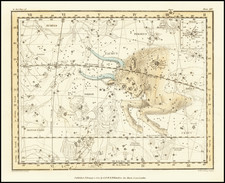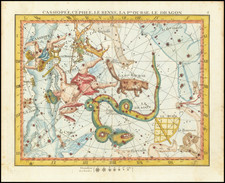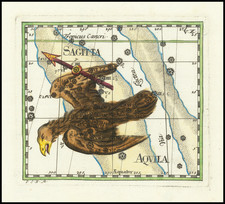The Great Comet
A leaf from Hartmann Schedel's famous 1493 publication Nuremberg Chronicle (Liber Chronicarum) which related the history of the world from biblical to contemporary time. Perhaps one of the more famous leaves from the work, the pictured engraving entitled Cometa insignia (The Remarkable Comet) depicts the artist's representation of the Great Comet of 1264 C.E. The text describes how in 1264 a "new star appeared in the sky," brighter than all the others. This corresponds with contemporary reports from across the globe that record a new or "guest" star in the sky during this period. With this new star supposedly came three months of rain and storms, culminating in a plague that decimated the populace. The text at the bottom describes contemporary beliefs about the comet and the reason why it vanished:
"It appeared in the sky with remarkable size for over three months, rising from the east with great light. And for a long time in the western part of the sky, it sent forth its rays. Before it appeared, Pope Urban IV fell ill, but on the same night that Urban died, the comet was extinguished; thus, its appearance faded away."
A popular opinion of the period believed that the comet heralded bad tidings for Christendom and that Urban's death was a necessary sacrifice to break its curse. Due to the prominent role Pope Urban IV played in this tale, it is unsurprising that this leaf also illustrates the pontifical line of Popes Urban and Clements.
This mention of comets heralding bad tidings is a similar theme echoed through other appearances of comets in history, namely 1066 and the Battle of Hastings where King Harold Godwinson was defeated by William the Conqueror, effectively losing control of England to the Normans. Hally's Comment is depicted in the Bayeux Tapestry which shows fearful advisors and King Harold watching as the comet passes overhead. The theme of comets heralding great change in the world is an ancient motif with this leaf reflecting the continued power of this belief on human society.
Stanford University holds a copy of this leaf in their Special Collections.
Hartmann Schedel (1440-1514) was a physician, book collector, and writer whose most famous work, the Liber Chronicarum (Nuremberg Chronicle), included some of the first printed views of many cities in Europe and across the world.
Schedel was born and died in Nuremberg, but he also traveled for his education. From 1456 to 1463 he lived in Leipzig, where he attended the University of Leipzig and earned his MA. From there he went to Padua, where he earned a Doctor of Medicine in 1466. After university, he worked for a time in Nördlingen and then returned to Nuremberg. In 1482 he was elected a member of the Great Council of Nuremberg.
The Chronicle was published in 1493. Besides this major work, one of Schedel’s most enduring legacies is his magnificent manuscript and printed book collection, one of the largest of the fifteenth century. In 1552, Schedel's grandson, Melchior Schedel, sold about 370 manuscripts and 600 printed works from Hartmann Schedel's library to Johann Jakob Fugger. Fugger later sold his library to Duke Albert V of Bavaria in 1571. This library is now mostly preserved in the Bayerische Staasbibliothek in Munich.
Among the surviving portions of Schedel's library are the records for the publication of the Chronicle, including Schedel's contract with Anton Koberger for the publication of the work and the financing of the work by Sebald Schreyer and Sebastian Kammermeister, as well as the contracts with Wohlgemut and Pleydenwurff for the original artworks and engravings. The collection also includes original manuscript copies of the work in Latin and German.










![[Olivier van Noort Portrait / World Map]](https://storage.googleapis.com/raremaps/img/small/79567.jpg)

![Sphere Droite [and] Sphere Parallele](https://storage.googleapis.com/raremaps/img/small/6208.jpg)

![[ Early Infographic Chart ] Geography Epitomiz'd. Of The Stars And Planets. Of The Sun And Moon. Of the Air and Meteors. The Terms of Geography Explain'd.](https://storage.googleapis.com/raremaps/img/small/101679.jpg)